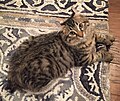Description
The Highlander originated as a crossbreed of the experimental Desert Lynx breed and the Jungle Curl, to add the latter's curled ears to the former. [1] [2] They are bobtailed or short-tailed, have spotted or classic bullseye markings, mackerel and resemble the bobcat. [1] [3] The Highlander has a long sloping forehead and blunt muzzle with a very wide nose. [3] The eyes are wide-set and the ears are upright with a slight curl and a slight turn in the backward direction. [3] The body is substantial and very muscular. [3] Females can grow to between 10 and 14 pounds (4.5 and 6.4 kg), and the males between 15 and 20 pounds (6.8 and 9.1 kg). [2] Despite the "big-cat look", the Highlander is a human-oriented, friendly and playful cat, and very active and confident. [2] The Highlander displays tabby/lynx point or solid point coloration in various colors. Bicolored cats are not allowed in the breed standard. Although some cats are polydactyl, it is not part of the standard and it is a disqualification in the show ring. [4]
History
The Highlander breed refinement began in 2004, to distinguish the breed better from its foundation stock, and to seek competition status in major breed registries. [3] The name Highlander was adopted in late 2005. [3] Starting May 1, 2008, the breed was recognized by The International Cat Association (TICA) for competition in the Preliminary New Breed class, [3] and in 2016 was moved up to Advanced New Breed. [5] TICA divides Highlanders into two varieties, under the names Highlander Shorthair (HGS) and simply Highlander (HG) for the longer-haired variation. [3] [6] In 2022, the Highlander was accepted as a championship breed in the American Cat Fanciers Association (ACFA). [7]
Closeup of Highlander face, with curled ears and distinctive facial features
Tabby markings and bobtail
Show champion Highlander, mink spotted tabby
Silver spotted tabby Highlander
Male Highlander cat
Highlander kitten
Highlander juvenile, 4 months old, with polydactyl paws.
This page is based on this
Wikipedia article Text is available under the
CC BY-SA 4.0 license; additional terms may apply.
Images, videos and audio are available under their respective licenses.







